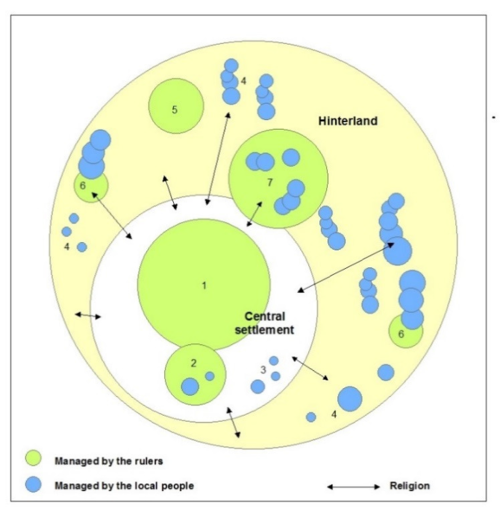Ancient water management and governance
According to the ancient chronicles, the tank-based irrigation system was initiated in the 4th/3rd century BCE in the Dry Zone of Sri Lanka and was abandoned in the middle of the 13th century CE. In the 19th century CE, it was reused under the British colonial government.
From the 5th century BCE onwards a system of large- and small-scale tanks developed over the centuries. The implementation of the water management and governance structures resulted from their continued use in a strengthened economic situation due to a stable food supply. A centralized bureaucratic administration was set up for the management of these large-scale systems in the later part of the Middle Historic Period (3rd–13th century CE). As a result, when the central government disintegrated the main irrigation systems were largely abandoned. In contrast local communities continue to sustain their small village tanks. Consequently on a local level the vulnerability of the tank-cascade systems to changing political and thus socio-economic boundary conditions has proven to be lower than that of the large-scale centrally managed tanks. In conclusion: the ancient capital of Anuradhapura and its hinterland display a unique example of a water management and governance system developed in harmony with a dual patronage between rulers and local people.
To retrace the historical development of the ancient water management and governance structures in the Dry Zone of Sri Lanka, a systematic analysis of ancient text passages was carried out. This allowed colonial politics and interventions during reclamation to also be critically analyzed. From the studies, a range of information could be obtained, exemplarily compiled in the following categories:
1. Grants of irrigation: “The Nacadaka canal in Ambagama [is given] to the Sangha”. (IC-1, Nos. 379–380)
2. Irrigation ownership: “The pond of the chief Phussadeva, the revenue officer of the king”. (IC-1, No. 703)
3. Irrigation professions: “The cave of the chief Uvahajanaka, proprietor of the tank Kadapi”. (IC-1, No. 1151)
4. Official announcements: “(These are) the immunities in the ninth (regnal) year of His Majesty Srisamboy in respect of the fish that bless the waters of this pond and the flora around it. This is the edictal stone prohibiting anyone from committing anything illegal around this pond”. (IC-5, Part-1, 14.9)
5. Irrigation income: “(…) The Uparaja Tissa (has granted) as the property of the Sangha one share of the (three) main shares of the tank of Rajakola”. (IC-2, Part-1, 51)
